Effect of Cyclic Loading on Mode I Fracture Toughness of Granite under Real-Time High-Temperature Conditions
Abstract
:1. Introduction
2. Materials and Methods
2.1. Materials
2.2. Methods
3. Results and Discussion
3.1. Load–Displacement Curve
3.2. Cumulative Vertical Displacement
3.3. Evolution of Elastic Stiffness
3.4. Mode I Fracture Toughness
3.5. Fracture Surface Morphology
4. Conclusions
- At a temperature of 25 °C, the CVD of the granite progressively increased with an increase in the number of cycles, primarily accumulating during the early and damage stages of cyclic loading. In the temperature range of 200 °C to 400 °C, the thermal hardening effect led to a trend in the CVD of granite, shifting from a decrease to an increase with an increasing number of cycles.
- Under cyclic loading, the elastic stiffness of granite exhibited a pattern of increasing–stabilizing–decreasing with a growing number of cycles. After the initial loading cycle, granite stiffness increased substantially by 70% to 80%.
- When temperatures surpassed 200 °C, two substantial reductions were observed in the damage threshold. At 300 °C, the threshold dropped below 80% of the upper load limit, and it further decreased to less than 75% as the temperature reached 400 °C.
- The microstructure of granite was significantly influenced by high temperature and cyclic loading. Below 300 °C, a comparison of SEM images from fracture surfaces in MTB and CTB tests revealed an increase in microfracture zones, cracks, scattered particles, and the size of scattered particles after cyclic loading.
- Based on the analyses above, this study can serve as a valuable reference for cyclic hydraulic fracturing technology. For instance, a lower upper limit of circulating load can be chosen within a reasonable range to minimize the impact of mining on the geothermal reservoir, thereby reducing the risk of induced earthquakes. Alternatively, hydraulic fracturing can be employed to extract HDRs at the optimal temperature, creating a complex fracture network and thereby enhancing extraction efficiency. In future work, it is recommended to examine the effect of real-time elevated temperatures on the damage threshold, potentially considering even higher temperatures. Given that the maximum number of cycles was limited in the present study, further research will be conducted to explore experiments with an increasing number of cycle loads.
Author Contributions
Funding
Institutional Review Board Statement
Informed Consent Statement
Data Availability Statement
Acknowledgments
Conflicts of Interest
References
- Breede, K.; Dzebisashvili, K.; Liu, X.L.; Falcone, G. A systematic review of enhanced (or engineered) geothermal systems: Past, present and future. Geotherm. Energy 2013, 1, 4. [Google Scholar] [CrossRef]
- Yang, F.J.; Wang, G.L.; Hu, D.W.; Zhou, H.; Tan, X.F. Influence of water-rock interaction on permeability and heat conductivity of granite under high temperature and pressure conditions. Geothermics 2022, 100, 102347. [Google Scholar] [CrossRef]
- Engvik, A.K.; Bertram, A.; Kalthoff, J.F.; Stöckhert, B.; Austrheim, H.; Elvevold, S. Magma-driven hydraulic fracturing and infiltration of fluids into the damaged host rock, an example from Dronning Maud Land, Antarctica. J. Struct. Geol. 2005, 27, 839–854. [Google Scholar] [CrossRef]
- Ramstad, R.K.; Hilmo, B.O.; Brattli, B.; Skarphagen, H. Ground source energy in crystalline bedrock-increased energy extraction using hydraulic fracturing in boreholes. Bull. Eng. Geol. Environ. 2007, 66, 493–503. [Google Scholar] [CrossRef]
- Hofmann, H.; Babadagli, T.; Zimmermann, G. Hot water generation for oil sands processing from enhanced geothermal systems: Process simulation for different hydraulic fracturing scenarios. Appl. Energy 2014, 113, 524–547. [Google Scholar] [CrossRef]
- Evans, K.F.; Zappone, A.; Kraft, T.; Deichmann, N.; Moia, F. A survey of the induced seismic responses to fluid injection in geothermal and CO2 reservoirs in Europe. Geothermics 2012, 41, 30–54. [Google Scholar] [CrossRef]
- Diaz, M.B.; Kim, K.Y.; Jung, S.G. Effect of frequency during cyclic hydraulic fracturing and the process of fracture development in laboratory experiments. Int. J. Rock Mech. Min. Sci. 2020, 134, 104474. [Google Scholar] [CrossRef]
- Li, Z.; Kwang, Y.K.; Sung, G.J.; Melvin, D.; Min, K.B.; Zang, A.; Stephansson, O.; Zimmermann, G.; Yoon, J.S.; Hofmann, H. Cyclic hydraulic of pocheon granite cores and its impact on breakdown pressure, acoustic emission amplitudes and injectivity. Int. J. Rock Mech. Min. Sci. 2019, 122, 104065. [Google Scholar]
- Ji, Y.L.; Zhuang, L.; Wu, W.; Hofmann, H.; Zang, A.; Zimmermann, G. Cyclic Water Injection Potentially Mitigates Seismic Risks by Promoting Slow and Stable Slip of a Natural Fracture in Granite. Rock Mech. Rock Eng. 2021, 54, 5389–5405. [Google Scholar] [CrossRef]
- Patel, S.M.; Sondergeld, C.H.; Rai, C.S. Laboratory studies of hydraulic fracturing by cyclic injection. Int. J. Rock Mech. Min. Sci. 2017, 95, 8–15. [Google Scholar] [CrossRef]
- Zang, A.; Stephansson, O.; Zimmermann, G. Keynote: Fatigue Hydraulic Fracturing. Procedia Eng. 2017, 191, 1126–1134. [Google Scholar] [CrossRef]
- Li, N.; Xie, H.P.; Hu, J.J.; Li, C.B. A critical review of the experimental and theoretical research on cyclic hydraulic fracturing for geothermal reservoir stimulation. Geomech. Geophys. Geo-Energy Geo-Resour. 2022, 8, 7. [Google Scholar] [CrossRef]
- Nasseri, M.H.B.; Schubnel, A.; Young, R.P. Coupled evolutions of fracture toughness and elastic wave velocities at high crack density in thermally treated Westerly granite. Int. J. Rock Mech. Min. Sci. 2007, 44, 601–616. [Google Scholar] [CrossRef]
- Al-Arifi, N.; El-Din, G.K.; Abdelkareem, M.; Abdalla, F. Integration of remote-sensing, structural, and geochemical data for characterizing granitoid rocks in Um Naggat pluton, Central Eastern Desert, Egypt. Arab. J. Geosci. 2021, 14, 50. [Google Scholar] [CrossRef]
- Balme, M.R.; Rocchi, V.; Jones, C.; Sammonds, P.R.; Meredith, P.G.; Boon, S. Fracture toughness measurements on igneous rocks using a high-pressure, high-temperature rock fracture mechanics cell. J. Volcanol. Geotherm. Res. 2004, 132, 159–172. [Google Scholar] [CrossRef]
- Xue, Y.; Liu, S.; Chai, J.R.; Liu, J.; Ranjith, P.G.; Cai, C.Z.; Gao, F.; Bai, X. Effect of water-cooling shock on fracture initiation and morphology of high-temperature granite: Application of hydraulic fracturing to enhanced geothermal systems. Appl. Energy 2023, 337, 120858. [Google Scholar] [CrossRef]
- Alneasan, M.; Alzo’ubi, A.K. Comprehensive investigation of rock fracture behaviour in clay-rich rocks under the effect of temperature: Experimental study under three loading modes (I, I/II, II). Eng. Fract. Mech. 2022, 276, 108933. [Google Scholar] [CrossRef]
- Meredith, P.G.; Atkinson, B.K. Fracture toughness and subcritical crack growth during high-temperature tensile deformation of Westerly granite and Black gabbro. Phys. Earth Planet. Inter. 1985, 39, 33–51. [Google Scholar] [CrossRef]
- Mahanta, B.; Singh, T.N.; Ranjith, P.G. Influence of thermal treatment on mode I fracture toughness of certain Indian rocks. Eng. Geol. 2016, 210, 103–114. [Google Scholar] [CrossRef]
- Zhang, J.S.; Lu, Y.; Pang, J.Y.; Bu, Y.S. Experimental Study on Mechanical Properties of High Temperature Granite with Different Cooling Methods. Appl. Sci. 2022, 12, 5968. [Google Scholar] [CrossRef]
- Feng, G.; Kang, Y.; Meng, T.; Hu, Y.Q.; Li, X.H. The Influence of Temperature on Mode I Fracture Toughness and Fracture Characteristics of Sandstone. Rock Mech. Rock Eng. 2017, 50, 2007–2019. [Google Scholar] [CrossRef]
- Zheng, Y.D.; Zhang, L.Y.; Wu, P.; Guo, X.Q.; Li, M.; Zhu, F.Q. Physical and Mechanical Properties and Damage Mechanism of Sandstone at High Temperatures. Appl. Sci. 2024, 14, 444. [Google Scholar] [CrossRef]
- Wang, K.; Xia, Z.T.; Huang, Z.; Li, X. Damage Evolution of Sandstone under Constant-Amplitude Cyclic Loading Based on Acoustic Emission Parameters and Resistivity. Adv. Mater. Sci. Eng. 2021, 2021, 7057183. [Google Scholar] [CrossRef]
- Wang, K.; Li, X.; Huang, Z.; Zhao, M.J. Experimental Study on Acoustic Emission and Resistivity Response of Sandstone under Constant Amplitude Cyclic Loading. Adv. Mater. Sci. Eng. 2021, 2021, 6637200. [Google Scholar] [CrossRef]
- Erarslan, N. Microstructural investigation of subcritical crack propagation and Fracture Process Zone (FPZ) by the reduction of rock fracture toughness under cyclic loading. Eng. Geol. 2016, 208, 181–190. [Google Scholar] [CrossRef]
- Guo, Q.F.; Wu, X.H.; Cai, M.F.; Miao, S.J. Experimental Study on the Effect of Offset Notch on Fracture Properties of Rock under Three-Point Bending Beam. Adv. Mater. Sci. Eng. 2020, 2020, 2781928. [Google Scholar] [CrossRef]
- Ma, G.; Li, J.T.; Zhou, X.; Chen, J.C.; Zhang, Y.; Qiu, P.T. Experimental and numerical investigations on fracture behaviours of cracked chevron notched Brazilian disc (CCNBD) sandstone specimen under cyclic loading. Eng. Fract. Mech. 2022, 271, 108673. [Google Scholar] [CrossRef]
- Wang, C.; Zhao, Z.; Zuo, C. Energy Behaviour of Coal Failure under Uniaxial Cyclic Loading/Unloading. Appl. Sci. 2023, 13, 4324. [Google Scholar] [CrossRef]
- Zhao, X.Y.; Dong, W.; Zhang, B.S.; Wang, Y.M. Fracture Properties of Rock-Concrete Interface after Fatigue Loading. J. Mater. Civ. Eng. 2023, 35, 04023033. [Google Scholar] [CrossRef]
- Zhu, Z.D.; Ni, X.H.; Hu, Z.H.; Huang, Q.; Li, X.J. Mesoscopic damage quantification research of the deformation and failure of granite under circulatory load with different frequencies. Eur. J. Environ. Civ. Eng. 2014, 17, s321–s333. [Google Scholar] [CrossRef]
- Ding, X.; Zhao, J.; Dong, Y.; Zhou, M. A Thorough Investigation of the Dynamic Properties of Granite under Cyclic Loading. Appl. Sci. 2023, 13, 12514. [Google Scholar] [CrossRef]
- Wang, Y.; Zhang, B.; Gao, S.H.; Li, C.H. Investigation on the effect of freeze-thaw on fracture mode classification in marble subjected to multi-level cyclic loads. Theor. Appl. Fract. Mech. 2021, 111, 102847. [Google Scholar] [CrossRef]
- Peng, K.; Shi, S.W.; Zou, Q.L.; Zhang, Y.J.; Tan, G.W. Gas Permeability Characteristics and Energy Evolution Laws of Gas-Bearing Coal under Multi-Level Stress Paths. Nat. Resour. Res. 2020, 21, 3137–3158. [Google Scholar] [CrossRef]
- Wang, Y.; Gao, S.H.; Li, C.H.; Han, J.Q. Investigation on fracture behaviors and damage evolution modeling of freeze-thawed marble subjected to increasing- amplitude cyclic loads. Theor. Appl. Fract. Mech. 2020, 109, 102679. [Google Scholar] [CrossRef]
- Wang, Y.; Gao, S.H.; Li, C.H.; Han, J.Q. Energy dissipation and damage evolution for dynamic fracture of marble subjected to freeze-thaw and multiple level compressive fatigue loading. Int. J. Fatigue 2020, 142, 105927. [Google Scholar] [CrossRef]
- Mccartney, J.S.; Sanchez, M.; Tomac, I. Energy geotechnics: Advances in subsurface energy recovery, storage, exchange, and waste management. Comput. Geotech. 2016, 75, 244–256. [Google Scholar] [CrossRef]
- Cui, Z.D.; Liu, D.A.; An, G.M.; Sun, B.; Zhou, M.; Cao, F.Q. A comparison of two ISRM suggested chevron notched specimens for testing mode-I rock fracture toughness. Int. J. Rock Mech. Min. Sci. 2010, 47, 871–876. [Google Scholar] [CrossRef]
- Dai, F.; Wei, M.D.; Xu, N.W.; Xu, Y. Numerical investigation of the progressive fracture mechanisms of four ISRM-suggested specimens for determining the mode I fracture toughness of rocks. Comput. Geotech. 2015, 69, 424–441. [Google Scholar] [CrossRef]
- Wong, L.N.Y.; Guo, T.Y. Microcracking behavior of two semi-circular bend specimens in mode I fracture toughness test of granite. Eng. Fract. Mech. 2019, 221, 106565. [Google Scholar] [CrossRef]
- Bahrami, B.; Ayatollahi, M.R.; Mirzaei, A.M.; Yahaya, Y.M. Support Type Influence on Rock Fracture Toughness Measurement Using Semi-circular Bending Specimen. Rock Mech. Rock Eng. 2019, 53, 2175–2183. [Google Scholar] [CrossRef]
- Andrea, M.I.; Jordi, D.M.; Miguel, C.; Juan, R.D.; Jose, A.L.; Jacobo, C.V. Pure Mode I Fracture Toughness Determination in Rocks Using a Pseudo-Compact Tension (pCT) Test Approach. Rock Mech. Rock Eng. 2020, 53, 3267–3285. [Google Scholar]
- Yin, T.B.; Wu, Y.; LI, Q.; Wang, C.; Wu, B.Q. Determination of double-K fracture toughness parameters of thermally treated granite using notched semi-circular bending specimen. Eng. Fract. Mech. 2020, 226, 106865. [Google Scholar] [CrossRef]
- Zhang, F.; Zhao, J.J.; Hu, D.W.; Skoczylas, F.; Shao, J.F. Laboratory Investigation on Physical and Mechanical Properties of Granite after Heating and Water-Cooling Treatment. Rock Mech. Rock Eng. 2018, 51, 677–694. [Google Scholar] [CrossRef]
- Zhang, F.; Dai, C.; Zhang, Y.H.; Guo, D.B.; Shao, J.F.; Hu, D.W. Experimental investigations on the tensile behaviour of granite after heating and water-cooling treatment. Bull. Eng. Geol. Environ. 2021, 80, 5909–5920. [Google Scholar] [CrossRef]
- Kuruppu, M.D.; Obara, Y.; Ayatollahi, M.R.; Chong, K.P.; Funatsu, T. ISRM-Suggested Method for Determining the Mode I Static Fracture Toughness Using Semi-Circular Bend Specimen. Rock Mech. Rock Eng. 2014, 47, 267–274. [Google Scholar] [CrossRef]
- Li, C.B.; Gao, C.; Xie, H.P.; Li, N. Experimental investigation of anisotropic fatigue characteristics of shale under uniaxial cyclic loading. Int. J. Rock Mech. Min. Sci. 2020, 130, 104314. [Google Scholar] [CrossRef]
- Wichtmann, T.; Niemunis, A.; Triantafyllidis, T. Strain accumulation in sand due to cyclic loading: Drained cyclic tests with triaxial extension. Soil Dyn. Earthq. Eng. 2007, 27, 42–48. [Google Scholar] [CrossRef]
- Zhang, Y.F.; Zhang, F.; Yang, K.; Cai, Z.Y. Effects of Real-Time High Temperature and Loading Rate on Deformation and Strength Behavior of Granite. Geofluids 2022, 2022, 9426378. [Google Scholar] [CrossRef]
- Ji, Y.L.; Yoon, J.S.; Zang, A.; Wu, W. Mitigation of injection-induced seismicity on undrained faults in granite using cyclic fluid injection: A laboratory study. Int. J. Rock Mech. Min. Sci. 2021, 146, 104881. [Google Scholar] [CrossRef]
- Fairhurst, C.E.; Hudson, J.A. Draft ISRM suggested method for the complete stress-strain curve for intact rock in uniaxial compression. Int. J. Rock Mech. Min. Sci. Geomech. Abstr. 1999, 36, 281–289. [Google Scholar]
- Luo, J.; Wang, L. Study on Energy Evolution and Damage Constitutive Model of Sandstone under Cyclic Loading and Unloading. Appl. Sci. 2023, 13, 1690. [Google Scholar] [CrossRef]
- Zhu, A.; Zhou, Z.; Zhang, Q.; Liao, Y.L.; Xu, D.; Liu, J.F. Study on mechanical properties and damage evolution characteristics of granite under different stress paths. Earth Environ. Sci. 2019, 332, 042023. [Google Scholar] [CrossRef]
- Fu, H.; Hu, K.; Shi, Y.; Li, J.; Wu, Y. Deformation Behaviour and Damage Evolution of Carbonaceous Phyllite under Cyclic Triaxial Loading. Materials 2023, 16, 4612. [Google Scholar] [CrossRef] [PubMed]
- Luo, J.; He, J. Mechanical Characteristics of Sandstone under High Temperature and Cyclic Loading in Underground Coal Gasification. Minerals 2022, 12, 1313. [Google Scholar] [CrossRef]
- Hu, B.; Hu, X.; Lin, C.; Du, G.; Ma, T.; Li, K. Evolution of Physical and Mechanical Properties of Granite after Thermal Treatment under Cyclic Uniaxial Compression. Sustainability 2023, 15, 13676. [Google Scholar] [CrossRef]
- Wang, Z.; Yang, Y.; Xu, Y.; Xin, C.; Liang, P.; Guo, N. Analysis of Energy Evolution and Acoustic Emission Characteristics of Rocks under Cyclic Loading and Unloading. Appl. Sci. 2023, 13, 10453. [Google Scholar] [CrossRef]
- Mo, H.H. Investigation of cyclic loading tests and constitutive relation of rock. Chin. J. Rock Mech. Eng. 1988, 7, 215–224. [Google Scholar]
- Yang, S.Q.; Ranjith, P.G.; Jing, H.W.; Tian, W.L.; Ju, Y. An experimental investigation on thermal damage and failure mechanical behavior of granite after exposure to different high temperature treatments–ScienceDirect. Geothermics 2017, 65, 180–197. [Google Scholar] [CrossRef]
- Ji, Y.L.; Wang, L.; Zheng, Y.L.; Wu, W. Temperature-dependent abrasivity of Bukit Timah granite and implicationsfor drill bit wear in thermo-mechanical drilling. Acta Geotech. 2020, 16, 885–893. [Google Scholar] [CrossRef]
- Ma, X.; Wang, G.L.; Hu, D.W.; Liu, Y.G.; Zhou, H.; Liu, F. Mechanical properties of granite under real-time high temperature and three-dimensional stress. Int. J. Rock Mech. Min. Sci. 2020, 136, 104521. [Google Scholar] [CrossRef]
- Zang, A.; Zimmermann, G.; Hofmann, H.; Stephansson, O.; Min, K.B.; Kim, K.Y. How to Reduce Fluid-Injection-Induced Seismicity. Rock Mech. Rock Eng. 2019, 52, 475–493. [Google Scholar] [CrossRef]
- Hofmann, H.; Zimmermann, G.; Farkas, M.; Huenges, E.; Zang, A.; Leonhardt, M.; Kwiatek, G.; Martinez-Garzon, P.; Bohnhoff, M.; Min, K.B.; et al. First field application of cyclic soft stimulation at the Pohang Enhanced Geothermal System site in Korea. Geophys. J. Int. 2019, 217, 926–949. [Google Scholar] [CrossRef]
- Kumari, W.G.P.; Ranjith, P.G.; Perera, M.S.A.; Chen, B.K. Experimental investigation of quenching effect on mechanical, microstructural and flow characteristics of reservoir rocks: Thermal stimulation method for geothermal energy extraction. J. Pet. Sci. Eng. 2018, 162, 419–433. [Google Scholar] [CrossRef]
- Kataoka, M.; Obara, Y.; Kuruppu, M. Estimation of Fracture Toughness of Anisotropic Rocks by Semi-Circular Bend (SCB) Tests Under Water Vapor Pressure. Rock Mech. Rock Eng. 2015, 48, 1353–1367. [Google Scholar] [CrossRef]
- Jiang, Y.F.; Zhu, Z.M.; Yu, L.Y.; Zhou, L.; Zhang, R.F.; Ma, L.J. Investigation of the fracture characteristics of granite and green sandstone under different thermal treatments. Theor. Appl. Fract. Mech. 2021, 118, 103217. [Google Scholar] [CrossRef]
- Song, Y.; Li, K.S.; Tian, W.L. Mechanical response of sandstone exposed to monotonic and multilevel fatigue loading: Insights from deformation, energy and acoustic emission characteristics. Theor. Appl. Fract. Mech. 2023, 128, 104181. [Google Scholar] [CrossRef]
- Yang, F.J.; Wang, G.L.; Hu, D.W.; Liu, Y.G.; Zhou, H.; Tan, X.F. Calibrations of thermo-hydro-mechanical coupling parameters for heating and water-cooling treated granite. Renew. Energy 2021, 168, 544–558. [Google Scholar] [CrossRef]
- Erarslan, N.; Williams, D.J. The damage mechanism of rock fatigue and its relationship to the fracture toughness of rocks. Int. J. Rock Mech. Min. Sci. 2012, 56, 15–26. [Google Scholar] [CrossRef]
- Wang, J.; Li, J.T.; Shi, Z.M.; Chen, J.C.; Lin, H. Fatigue characteristics and fracture behaviour of sandstone under discontinuous multilevel constant-amplitude fatigue disturbance. Eng. Fract. Mech. 2022, 274, 108773. [Google Scholar] [CrossRef]
- Chen, Y.; Chen, Y.; Zhang, Y.; Zhang, J.; Chen, T. Mechanical Properties and Penetration Characteristics of Mudstone Slag-Based Waterproof Composites under Cyclic Loading. Appl. Sci. 2024, 14, 198. [Google Scholar] [CrossRef]
- Shi, Z.M.; Li, J.T.; Wang, J. Research on the fracture mode and damage evolution model of sandstone containing pre-existing crack under different stress paths. Eng. Fract. Mech. 2022, 264, 108299. [Google Scholar] [CrossRef]
- Zhang, L.; Yang, D.X.; Zhao, K.; Yunge Zhao, Y.G.; Jin, J.F.; Wang, X.J.; Zhu, L.J.; Wang, X.; Li, C.M. Investigation of high-temperature effects on the strengthening and degradation of mechanical property in sandstone. Appl. Energy 2024, 357, 122532. [Google Scholar] [CrossRef]
- Yang, K.; Zhang, F.; Meng, F.Z.; Hu, D.W.; Tan, X.F. Effect of real-time high temperature and loading rate on mode I fracture toughness of granite. Geotherm. Energy 2022, 10, 14. [Google Scholar] [CrossRef]
- Khvorostyanyi, V. Fracture Resistance of Brittle Materials Under Local Loading by Scratching to Edge Chipping. Part. 1. Methodical Grounds Research. Strength Mater. 2020, 52, 746–752. [Google Scholar] [CrossRef]
- Huang, L.Q.; Wang, J.; Momeni, A.; Wang, S.F. Spalling fracture mechanism of granite subjected to dynamic tensile loading. Trans. Nonferrous Met. Soc. China 2021, 31, 2116–2127. [Google Scholar] [CrossRef]

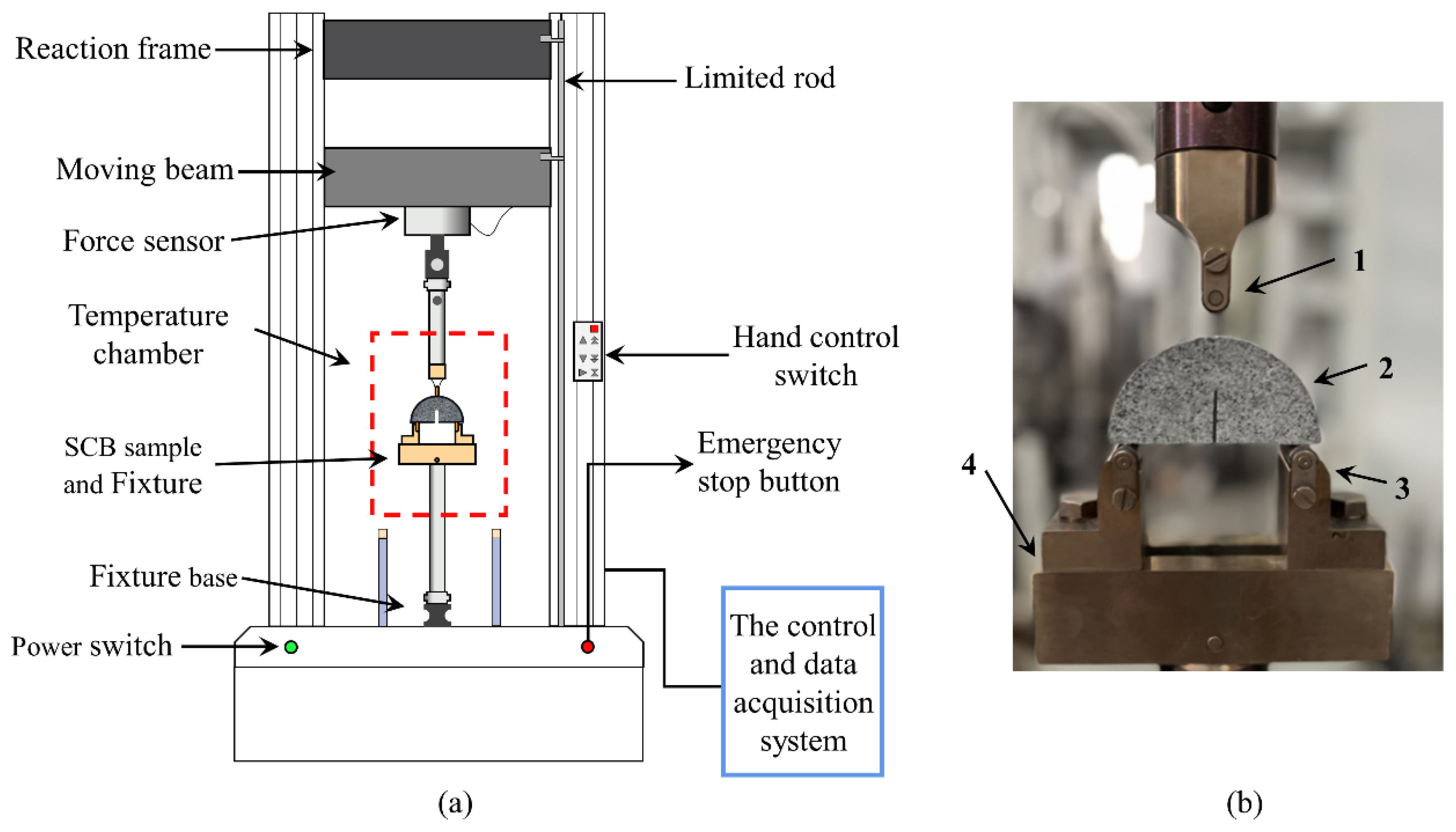
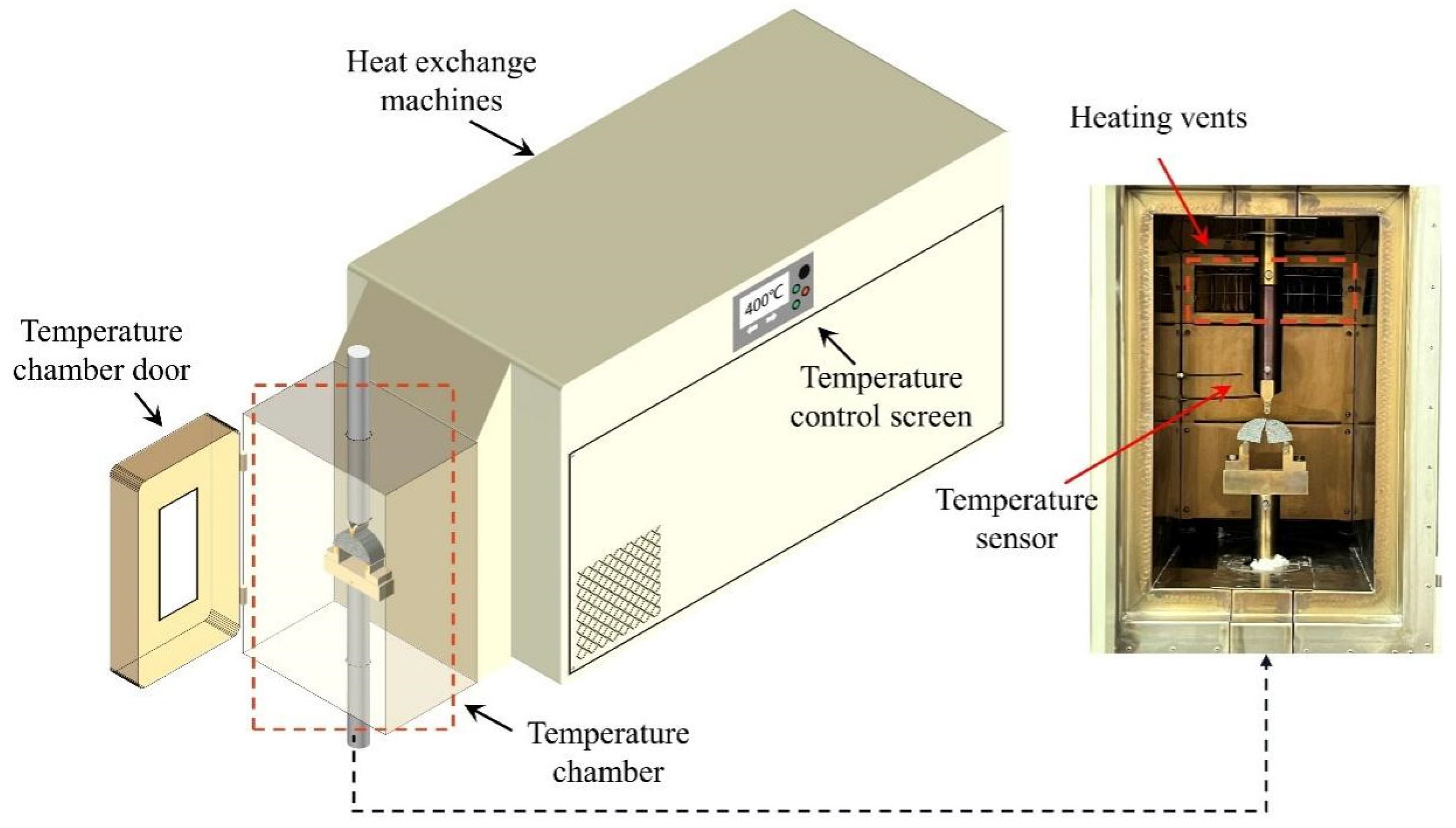
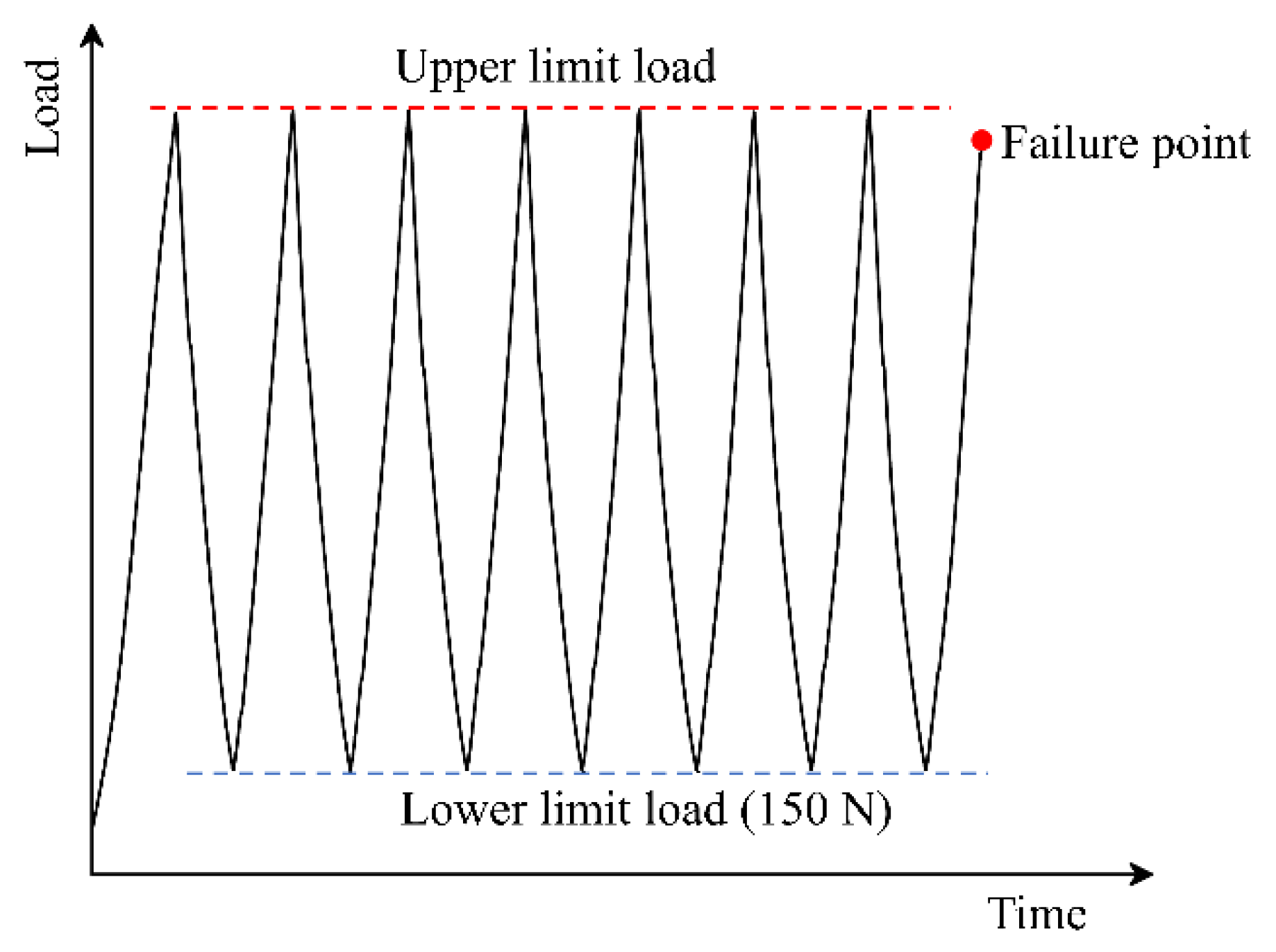
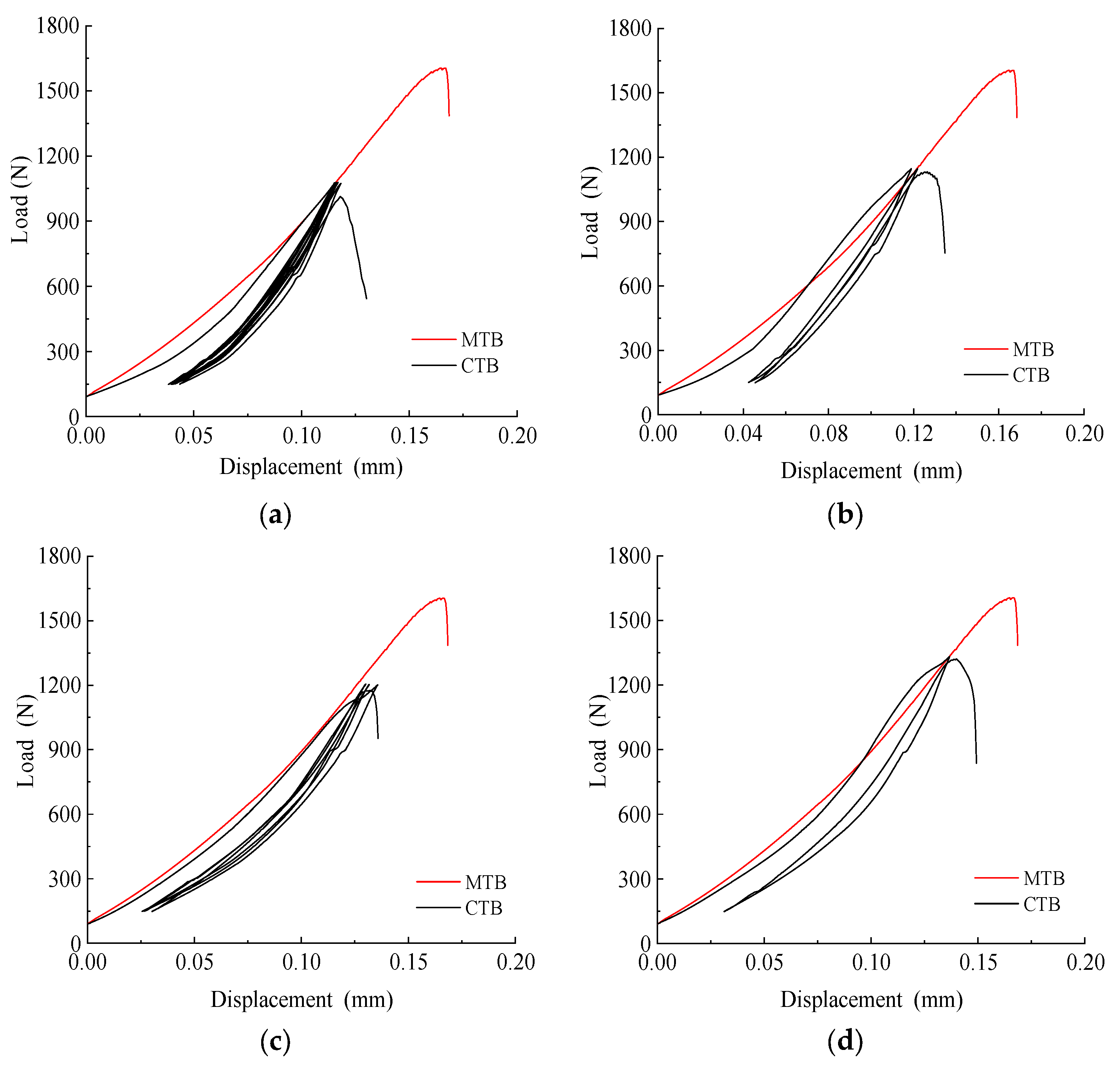
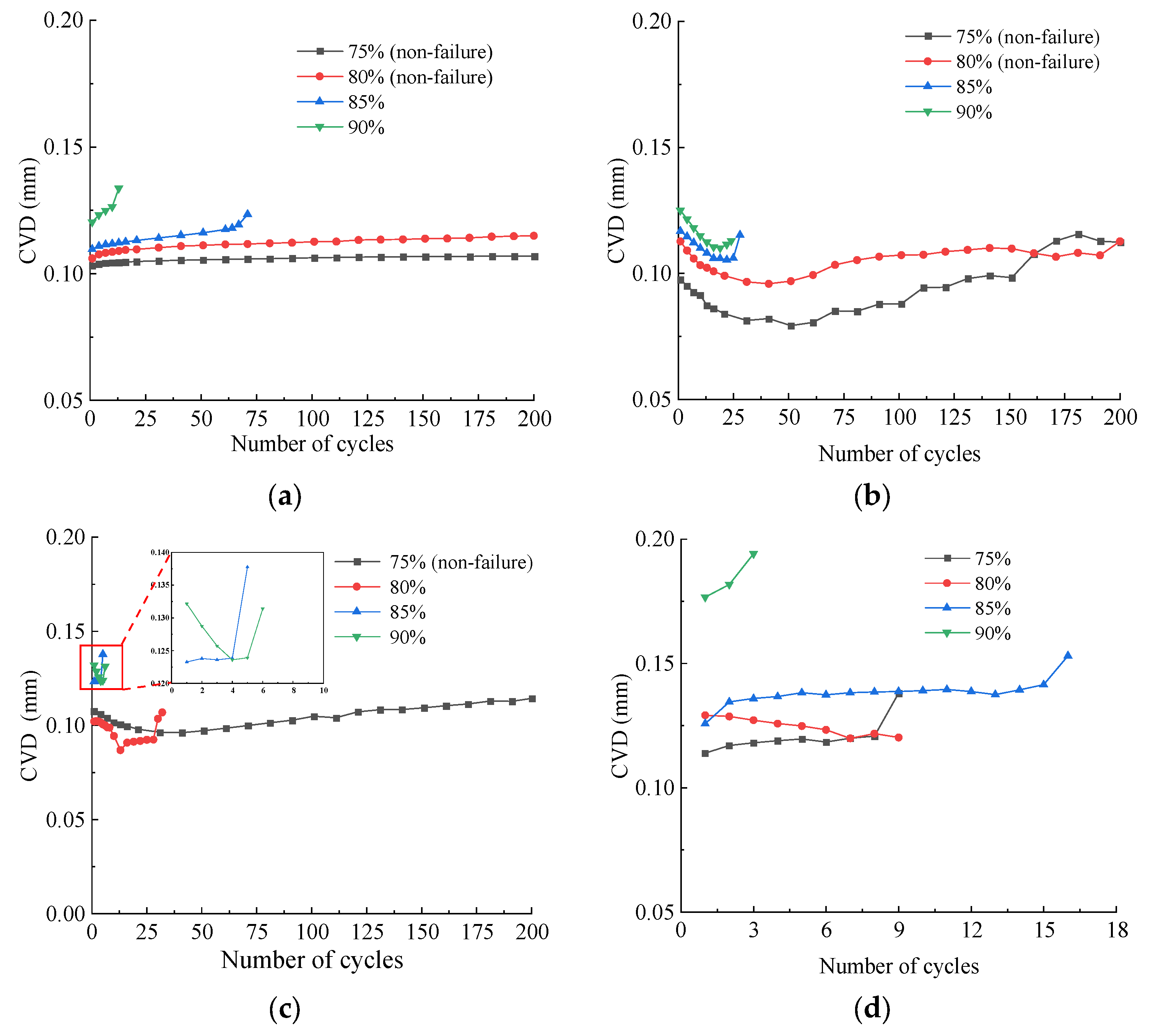

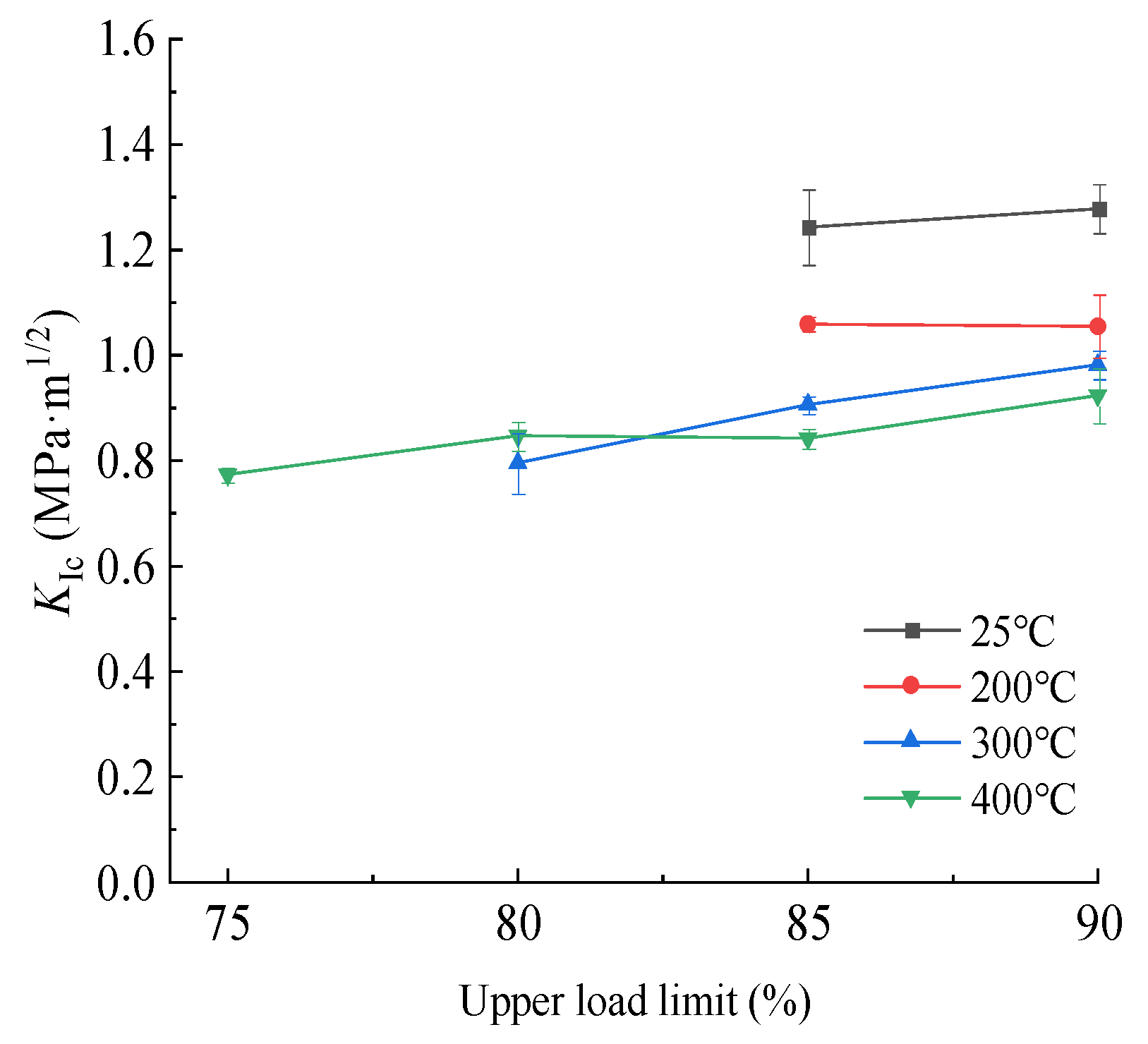

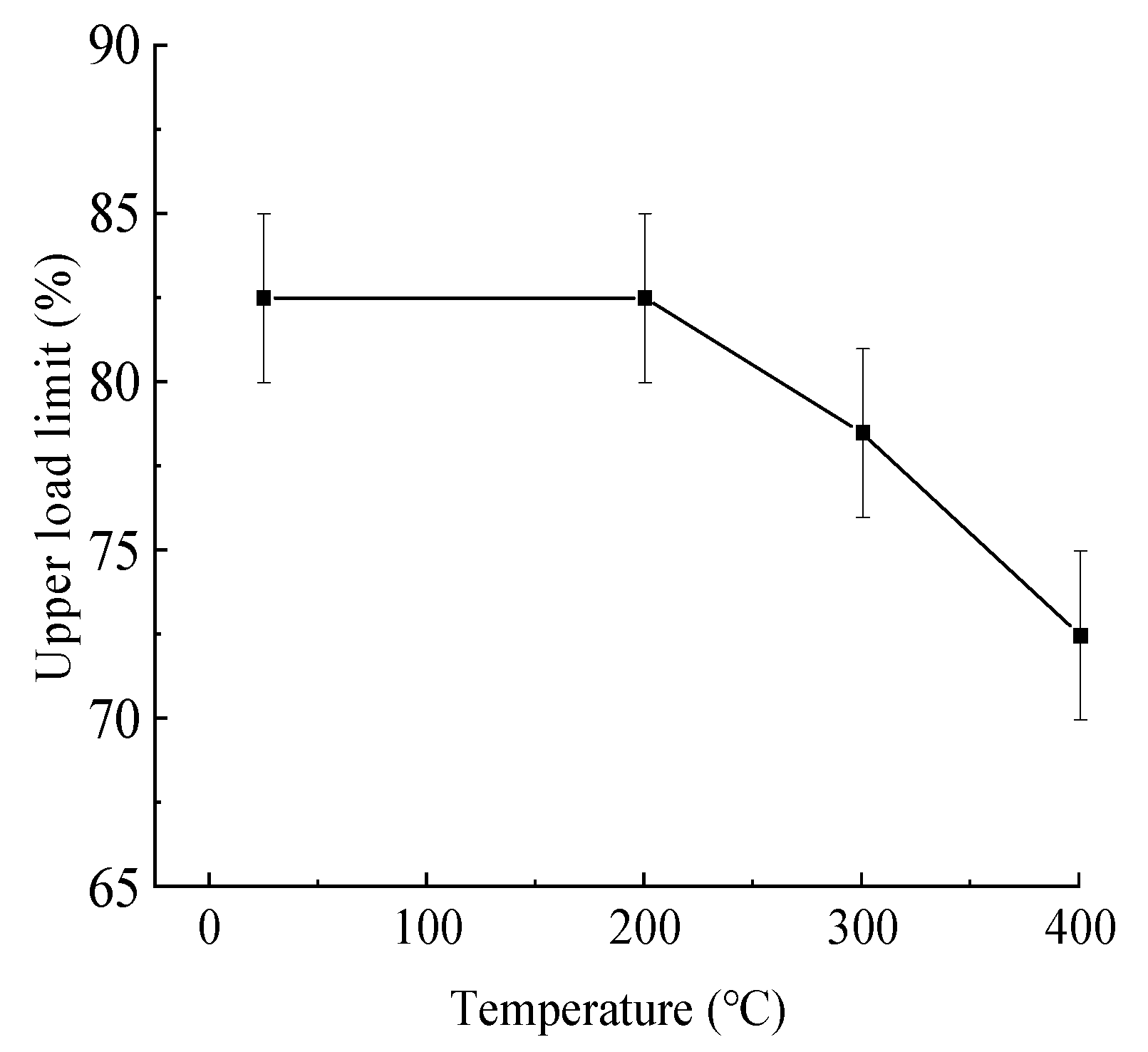
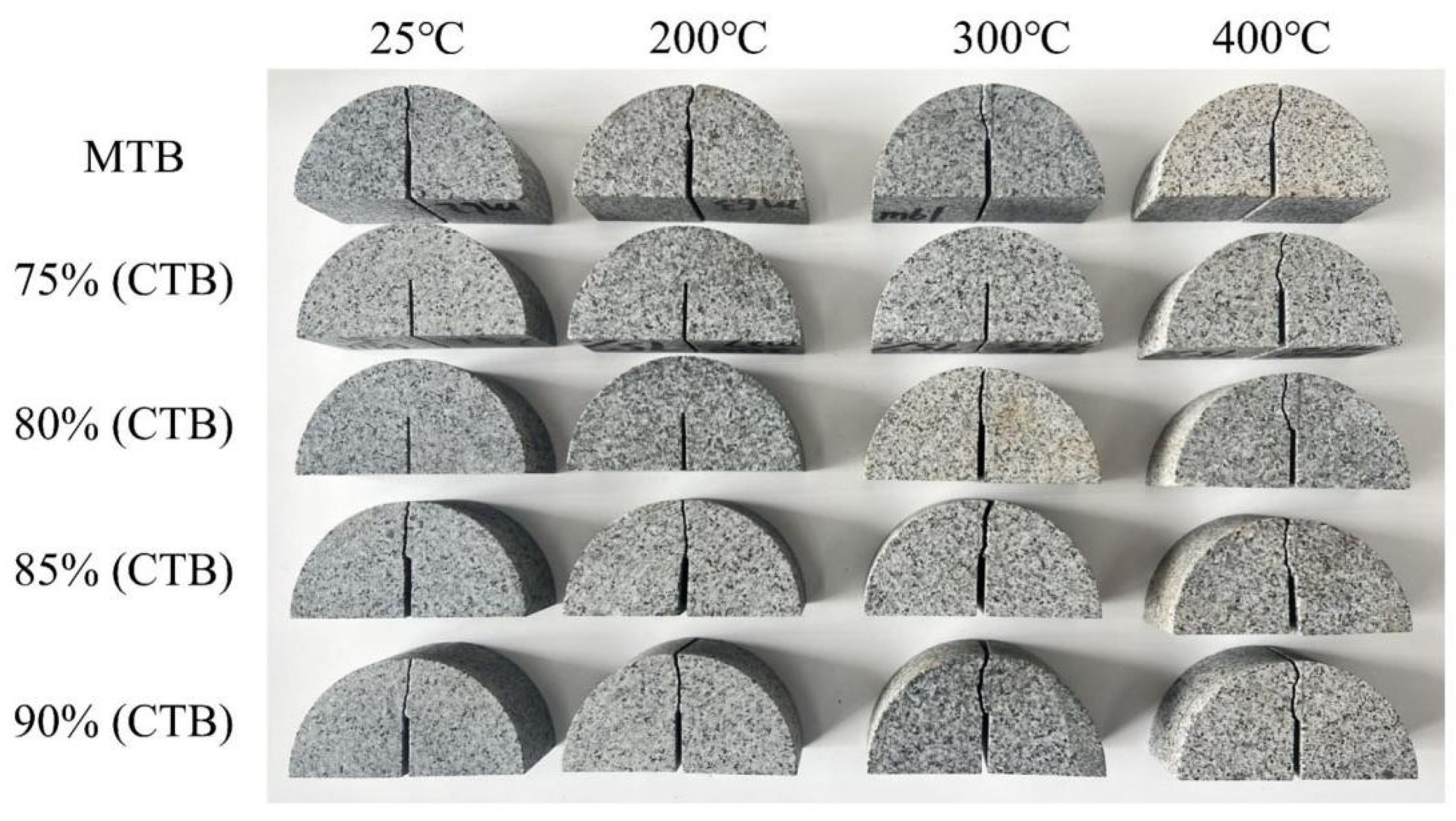
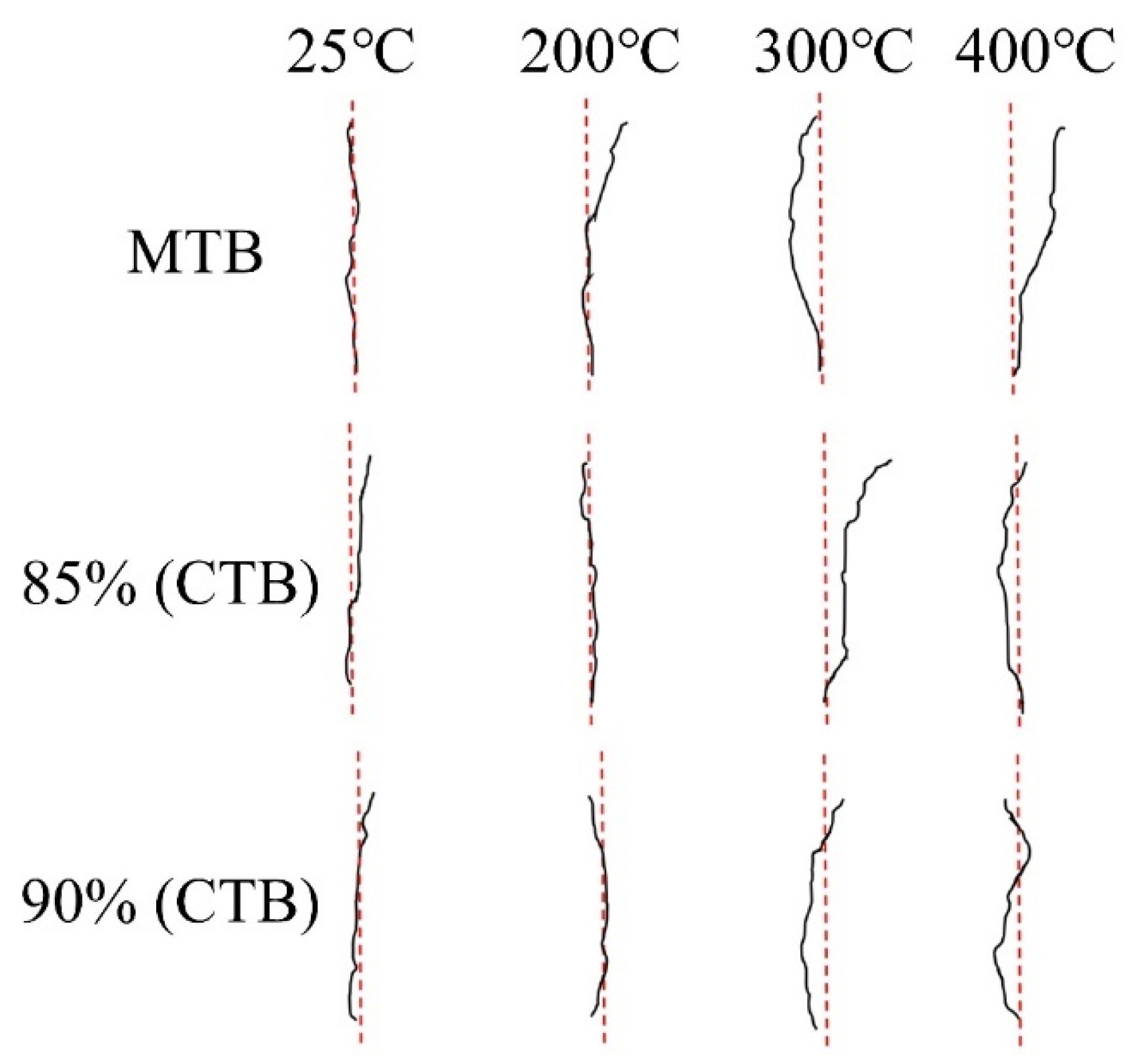
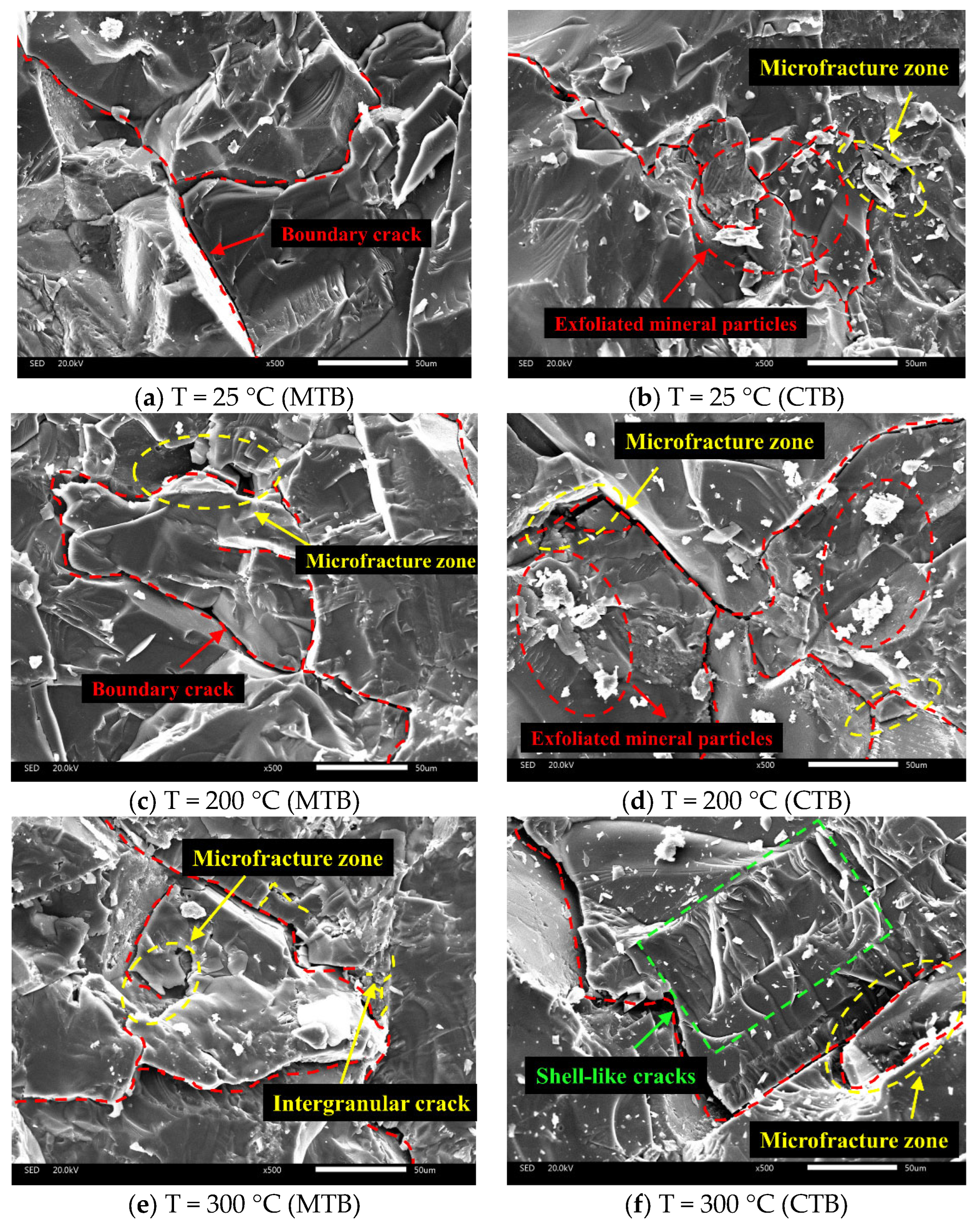
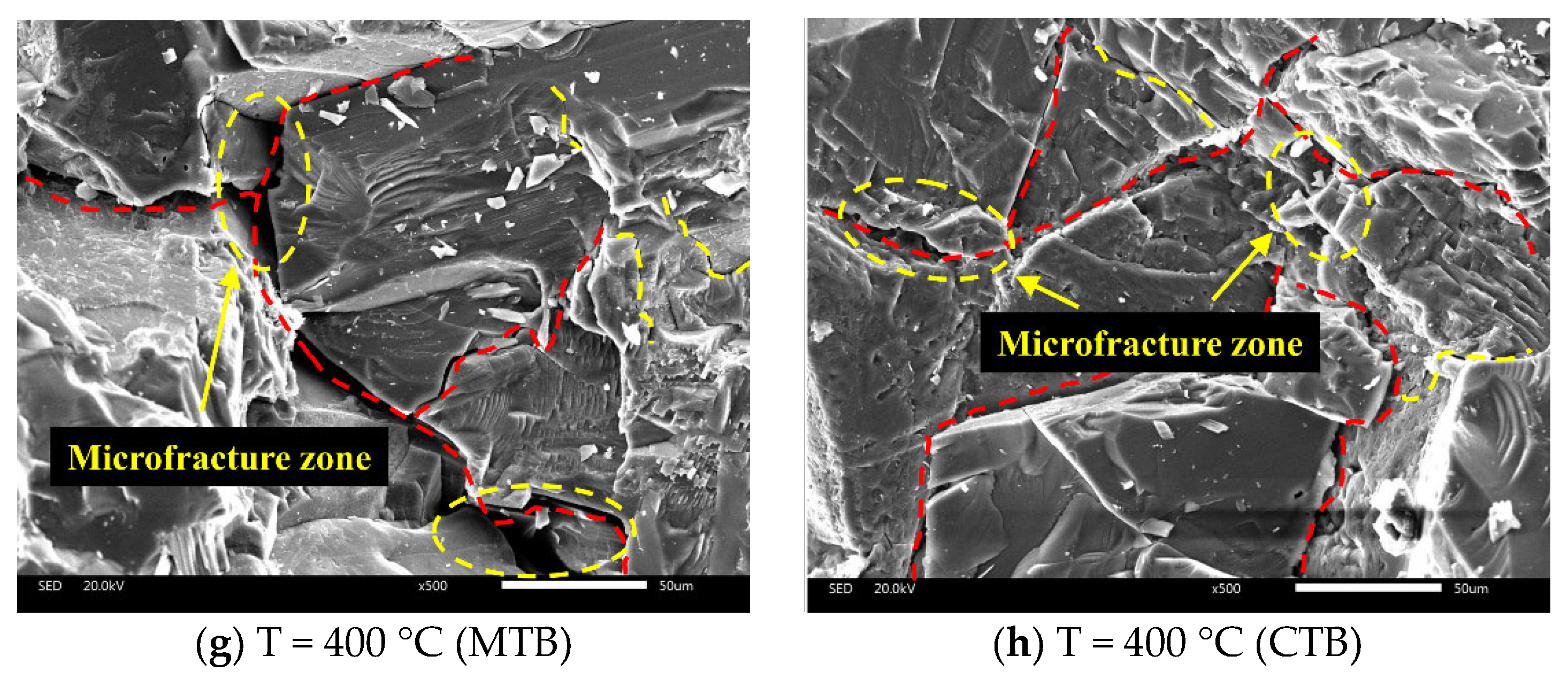
| R/(mm) | B/(mm) | t/(mm) | a/(mm) | S/(mm) |
|---|---|---|---|---|
| 38 ± 0.3 | 30 ± 0.2 | 1 | 19.5 ± 0.3 | 60.8 |
| Temperature (°C) | Peak Load of MTB Tests (N) | CTB Upper Load Limit | CTB Lower Limit Load (N) |
|---|---|---|---|
| 25 | Pmax(25 °C) = 1992 | 75% Pmax(25 °C) | 150 |
| 80% Pmax(25 °C) | |||
| 85% Pmax(25 °C) | |||
| 90% Pmax(25 °C) | |||
| 200 | Pmax(200 °C) = 1693 | 75% Pmax(200 °C) | 150 |
| 80% Pmax(200 °C) | |||
| 85% Pmax(200 °C) | |||
| 90% Pmax(200 °C) | |||
| 300 | Pmax(300 °C) = 1481 | 75% Pmax(300 °C) | 150 |
| 80% Pmax(300 °C) | |||
| 85% Pmax(300 °C) | |||
| 90% Pmax(300 °C) | |||
| 400 | Pmax(400 °C) = 1441 | 75% Pmax(400 °C) | 150 |
| 80% Pmax(400 °C) | |||
| 85% Pmax(400 °C) | |||
| 90% Pmax(400 °C) |
| T/(°C) | MTB KIc/ (MPa·m1/2) | ULL/(%) | Number of Cycles * | CTB KIc/ (MPa·m1/2) | DA/(%) | ||
|---|---|---|---|---|---|---|---|
| Sample 1 | Sample 2 | Sample 3 | |||||
| 25 | 1.52 | 75 | 200 | 200 | 200 | - | - |
| 80 | 200 | 200 | 200 | - | - | ||
| 85 | 61 | 71 | 1.24 | 18.25 | |||
| 90 | 11 | 36 | 13 | 1.28 | 14.19 | ||
| 200 | 1.27 | 75 | 200 | 200 | 200 | - | - |
| 80 | 200 | 200 | 200 | - | - | ||
| 85 | 27 | 16 | 12 | 1.06 | 16.29 | ||
| 90 | 8 | 23 | 15 | 1.06 | 16.23 | ||
| 300 | 1.11 | 75 | 200 | 200 | 200 | - | - |
| 80 | 29 | 30 | 9 | 0.80 | 27.81 | ||
| 85 | 5 | 49 | 136 | 0.91 | 19.68 | ||
| 90 | 33 | 15 | 6 | 0.98 | 14.46 | ||
| 400 | 1.05 | 75 | 8 | 11 | 17 | 0.77 | 27.14 |
| 80 | 18 | 3 | 4 | 0.85 | 19.38 | ||
| 85 | 13 | 12 | 6 | 0.84 | 19.55 | ||
| 90 | 4 | 3 | 4 | 0.82 | 13.36 | ||
Disclaimer/Publisher’s Note: The statements, opinions and data contained in all publications are solely those of the individual author(s) and contributor(s) and not of MDPI and/or the editor(s). MDPI and/or the editor(s) disclaim responsibility for any injury to people or property resulting from any ideas, methods, instructions or products referred to in the content. |
© 2024 by the authors. Licensee MDPI, Basel, Switzerland. This article is an open access article distributed under the terms and conditions of the Creative Commons Attribution (CC BY) license (https://creativecommons.org/licenses/by/4.0/).
Share and Cite
Lv, F.; Zhang, F.; Zhang, S.; Li, K.; Ma, S. Effect of Cyclic Loading on Mode I Fracture Toughness of Granite under Real-Time High-Temperature Conditions. Appl. Sci. 2024, 14, 755. https://doi.org/10.3390/app14020755
Lv F, Zhang F, Zhang S, Li K, Ma S. Effect of Cyclic Loading on Mode I Fracture Toughness of Granite under Real-Time High-Temperature Conditions. Applied Sciences. 2024; 14(2):755. https://doi.org/10.3390/app14020755
Chicago/Turabian StyleLv, Fei, Fan Zhang, Subiao Zhang, Kangwen Li, and Shuangze Ma. 2024. "Effect of Cyclic Loading on Mode I Fracture Toughness of Granite under Real-Time High-Temperature Conditions" Applied Sciences 14, no. 2: 755. https://doi.org/10.3390/app14020755




